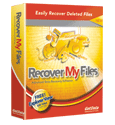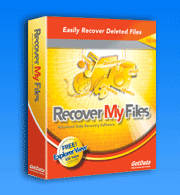Data recovery questions and answers
The following is a transcript of an interview with Graham Henley, one of the founders of GetData and authors of Recover My Files:
Q; Why, if data recovery software technology is so readily available, aren’t the overwhelming majority of us aware that it’s possible?
Well basically it is because the button on the keyboard says “delete”. Most computer users take this at face value and think that when you press the delete button it’s gone for ever, which is not the case.
Also we have all become very used to the Windows Recycle Bin, where you can move files that you no longer want, but can get them out before you empty the bin. Many people still don’t realize that with data recovery, even when the Recycle Bin is emptied there is still an opportunity to recover the files.
Q: How is it possible to recover missing files without sending your drive out to a company and risk something happening to the drive? (Or….Why is it not necessary to send your drive out to a company to recover your files?)
Data recovery can be put into two categories …
- when your computer hard drive is working perfectly, but you have deleted files, formatted your drive, or lost your data for some other reason. This is what is referred to in the industry as a “logical” problem.
- when you computer hard drive has physical errors and some of the mechanical or electrical components of the drive no longer work, for example when you computer has been in a fire or a flood. This is what is referred to in the industry as a “physical” problem.
In many cases the data has been lost due to a “logical” problems and a software solution can be used to recover files. It is only if you drive has physical errors that you need to send it to a hardware recovery service.
Q: In simple terms, what is the technology that allows a computer owner to recover their files right there at their desk?
Data recovery is possible because of the way the Microsoft Windows operating system is designed. Historically Windows has been developed to maximize the speed of computer use. Permanent erasure of data, whilst possible, takes time.
Q: What was the technical breakthrough that allows us to do this now?
Data recovery procedures have improved rapidly in recent years. A lot of this is due to the need by law enforcement agencies around the world to deal with electronic evidence.
Q: Is the ability to recover files limited to conventional hard-drives, or can files be recovered from other types of drives or media on which information may be stored
Files can be recovered from many different types of media, including hard drive, USB drives and digital camera storage cards.
Q: What risks are there to downloading a software application and having it search and recover your missing or deleted files?
When you download files from the Internet to your computer you should always make sure the file comes from a trusted source, no matter what the software does. This is a good basic security policy for your computer and will protect you from such things like viruses and spyware.
If you are looking for data recovery software you should make sure that:
- the software you use does NOT change the contents of the drive being searched. If the software does not work you want to be able to pursue other options to try and get your valuable data back.
- It is possible that deleted data can be destroyed and not recovered. You should be able to identify that the data recovery software has recovered your data before you purchase it. Recover My Files does this by having a file preview window which allows you to view pictures and documents.
Q: What sort of files will the data recovery software find?
Recover My Files can find any type of deleted file, but it also has support for more than 200 specific file types file. There are two methods to data recovery:
1. Every file on a computer, even the deleted ones, is identified by a record in a table called the Master File Table or MFT. A files MFT record tells the computer the name of the file and also the location on the disk where the file is stored. Recover My Files reads these MFT records to find and recover deleted or lost files.
2. In some circumstances the MFT records can become corrupt or destroyed. In this situation Windows has no reference information to locate the deleted or lost files, however, Recover My Files can look for and find user specified file types by scanning the storage media and looking for a files unique structure, that is, it’s unique header, content and footer.
Q: Does it take long, and could I keep working on my computer while the data recovery software is working?
You should limit the use of the computer until data recovery is finished. The more you use a computer the more chance you have of writing data to the storage media and overwriting and destroying deleted files that could have otherwise been recovered.
In some situations data recovery can take time. With a very large hard drive of 200GB, it may take up to 15 hours to search the entire disk.
Q: How do I begin and stop the software searching?
Recover My Files if straight forward to use. There are basically four steps.
1. Decide what search you want to run according to your situation, for example whether you have deleted files or formatted your drive.
2. Select the drive that you want to search. If you can no longer see a drive letter, Recover My Files allows you to search a drive at a “physical level”, meaning that it finds drive in your PC, starts at the beginning and goes to the end, ignoring all drive letters on the drive;
3. Select the specific file types, if any, that you are looking for;
4. Start the search and preview and save the results.
Q: How will I know if the software has found my missing files?
You will be able to see the file names and click on the recovered files to preview them.
Q: What do I do once the software has found them?
Select the files that you wish to save and then save them to another drive. You need to activate the program in order to do this, which means purchasing an activation key from www.recovermyfiles.com. The activation key I given to you at the time of your purchase so you can save the files straight away.
Q: Can I use the data recovery software over and over, if I have future problems with missing files, or is it a once-off?
Once you purchase Recover My Files you can use it over and over again. An activation key is valid for installation on two computers, for example, a desktop and a laptop.

Recover My Files download instructions
- Click the download button to begin the download.
- If possible, save then install the Recover My Files installation program on a drive other than the one on which your files were lost.
- Run Recover My Files, search your drive and preview the files found in the results screen.
- NOTE: Software will only run on Windows PC's
» Previous Versions






